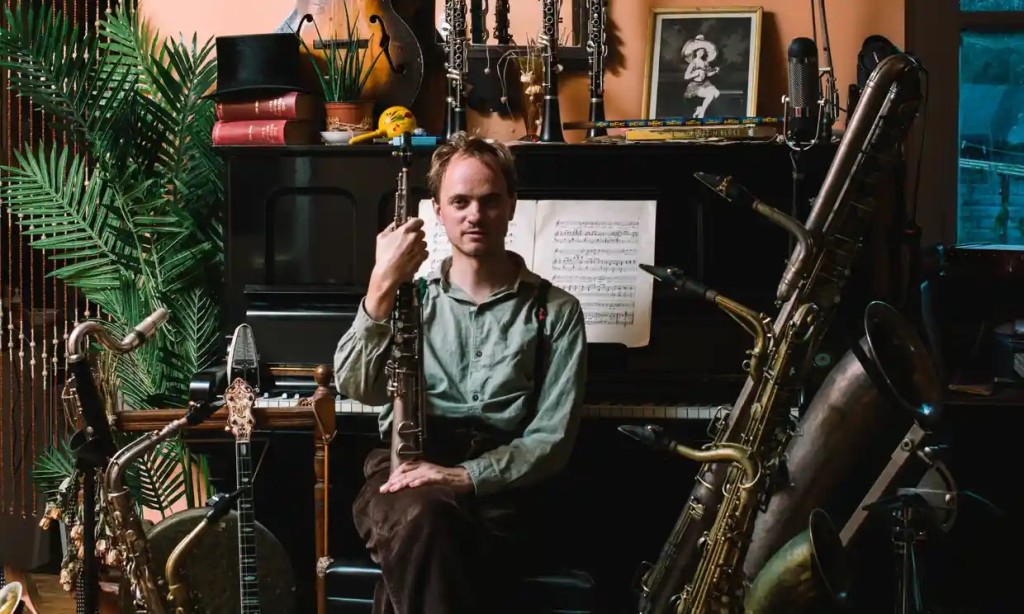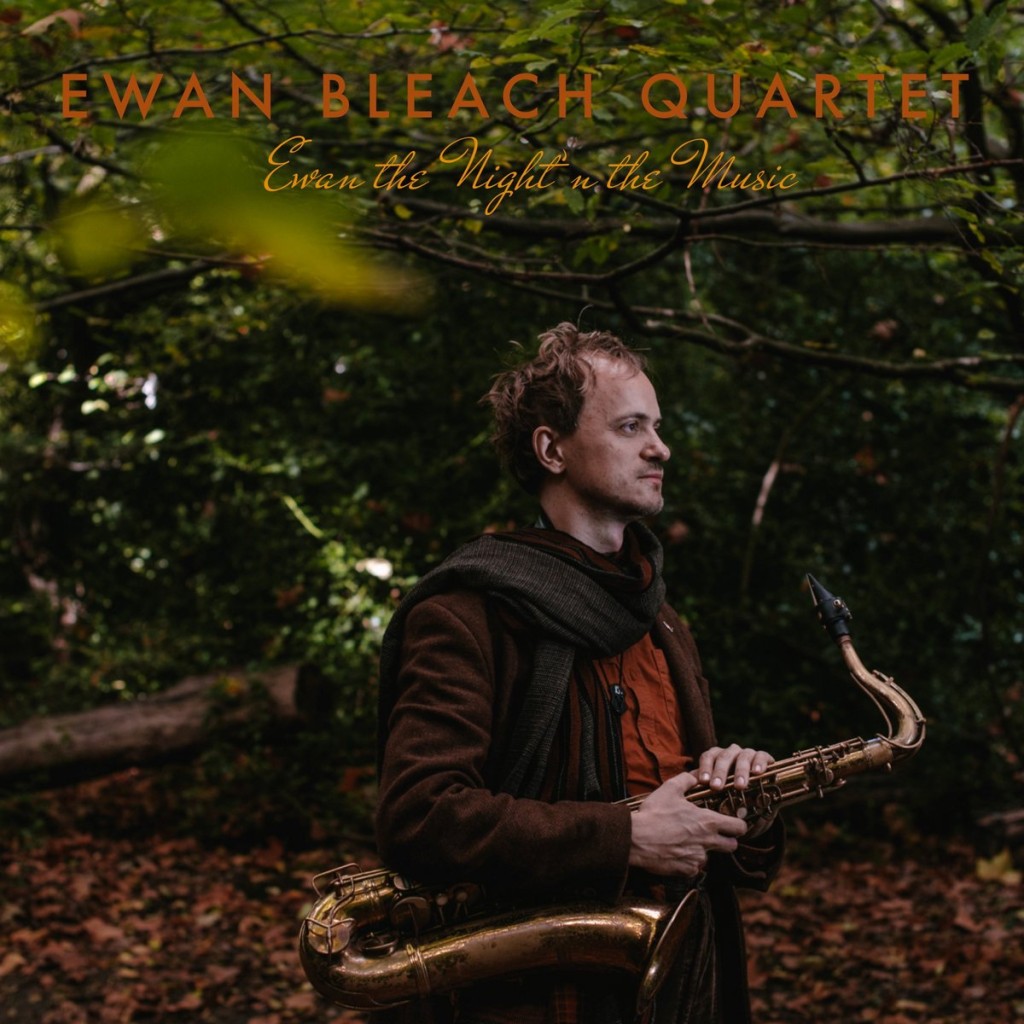If any modern, British musician embodies Louisiana circa 1920, it must be Ewan Bleach. Seeing him live, audiences would be forgiven for thinking he was born on the bayou with clarinet in hand. Invariably dressed in a collarless shirt with slacks and suspenders, his mastery of the instrument is such that he can play countless jazz standards—as well as waltzes, polkas and more—with just one hand, accompanying himself on the piano with the other. And in any key you care to name, to boot.
It’s a neat trick he whips out at solo gigs, but Ewan need never play alone. In huge demand both at home in the UK and abroad, he could scarcely work any harder: Check out the list of upcoming gigs on his website and you’ll notice that he is playing with some duo, band or orchestra almost every night of the month. He must have been immersed in traditional jazz almost from birth, you might think—but you would be wrong. Rather, the obsessive musician came to the idiom the long way around via classical, folk, and electronic dance music.
Born to proficient classical players, Ewan’s interest in music was almost inevitable. He took up the clarinet aged seven and the piano aged 12, but Bach and Brahms weren’t really doing it for him. Shortly thereafter, a friend lent Ewan a saxophone and he began listening to bebop. The attraction was as intense as it was instantaneous. “At that point, I just decided that I was going to be a famous jazz musician—that was my life now,” he told me on a video call from his London home. “I would just sit and think about what the cover of my jazz autobiography was going to look like, one day.”
Ewan would go on to study at the prestigious Guildhall School of Music and Drama—but not before one almighty rebellion against his straight-laced upbringing. “At 14 I got into a bad crowd, going to parties, drinking and smoking all night,” Ewan said. “So I was going to a lot of raves under motorway bridges—but I always took my sax. I’d just be jamming along to the DJs playing jungle music all night long.”
The people he hung out with were far removed from the modern British jazz fan—who tends to be middle-class and clean-cut, in my experience—but not too far from the kind of free-thinking itinerants who embraced the music when it first emerged. “They were hippies who lived on canal boats, and we would jam together all night,” Ewan explained. At that point, he was still all about bebop. “I was collecting Miles Davis albums, thinking I had to be cool and progressive. I’d just about given up classical and I was just learning all this modern jazz, being a rebel, jamming and getting high.”
But he quickly realized that the beatnik life wasn’t for him. “Those modern jazz settings where people stroked their beards and pretended they liked the music—this environment didn’t appeal to me,” said Ewan. At the same time, the boat folk opened his eyes to other idioms, including African dancing music and American swing. “Fats Waller had a brunch band which would start at 11am—it would be all the guys who were still going from the night before,” said Ewan. “I’d experienced all that, at these hippie festivals. I started meeting hippies who played swing and it really stayed with me—everyone dancing and having a great time.”
And so, when he did eventually enrol at Guildhall, he did so trepidatiously. “I said to my parents, ‘I’m not going to find my crowd here. I’m not going to click with them,’” Ewan told me. During his first year at the college, he felt adrift and disheartened. “All I knew was modern jazz, classical music, and getting high and dancing all night,” he explained. “In my second year I was jamming every Sunday night at Afro-funk jams—then I’d go to college and learn modern jazz and it just didn’t feel right. It just seemed like a game to show off how intellectual you were.”
But he did click with someone: a new friend gave him a Billie Holiday album and he was smitten with jazz all over again. “I honestly believed no one played that music any more,” he said. “I’d never seen a trad band in the pub. In my second year we did a Duke Ellington project and in my third year I discovered Sidney Bechet.” Ewan engrossed himself in the history of jazz and blues. “What I realized was that the Jazz Age was a rave scene—just with live music,” he declared—something I’d be very interested to read a thesis on, for one.
Ewan has since become a devoted scholar not just of jazz, but of the musics which informed it. “In old jazz I find my love of dance music, African music, and classical music,” he explained. “The whole history of Western classical music and African rhythm are both there—the stage and the club.” He added, “All this time I’d been playing so cool, laid back like Miles Davis—suddenly I realised that jazz can be so expressive, and also be dancing music at the same time. It completely destroys the idea of high-brow and low-brow because it’s pop music but also very beautiful art. It’s earthy and groovy, and yet very academic.”
The projects with which hard-working Ewan is affiliated include Tuba Skinny, Frog and Henry, the Ewan Bleach Quartet, the Man Overboard Quintet, the Cable Street Rag Band, Arifa’s Reefers (fronted by jazz singer Arifa Hafiz) and folksy fusion band Whisky Moon Face. “People call it folk, but I don’t know why,” said Ewan. “We play a lot of jazz and blues and I do a lot of improvising—it’s very much the concept of jazz, with solos and improvised counterpoint.”
The piano is a constant companion to the multi-talented musician, who is making the move from player to arranger and composer. “The very first time I enter someone’s house, I want to know where the piano is,” he said. “I spend most of my time sitting at a piano. I’ve always practiced with the piano present—whether I’m playing clarinet or sax—trying out chords and playing along with them. When I learn a song I always learn it on the piano.”
He accompanies a dance class on the instrument each week, and it often features in his live sets. “I do an opening piano set at the start of every Wednesday night gig,” said Ewan. “I play weird songs I don’t think the band will play. I’ve never been proud of my piano—I don’t put as much practice in, so there will also be more mistakes. But I just let it be a bit chaotic and rough around the edges.”
Ewan also performs regular gigs with guitarist friend John Kelly. “I can make great music happen just with John,” said Ewan, “because we’ve got this ‘Dynamic Duo’ thing going on.” These duet performances also feature Ewan’s party trick, playing clarinet with his left hand and piano with his right, using novel fingering he invented for the E-flat instrument. “It’s just something I developed over lockdown,” he told me. “I was bored and there were no other musicians in the house. I began with ‘I Get the Blues When it Rains’—now I have a whole one-handed repertoire.”
While it started off difficult, Ewan soon hit his stride. “So much about playing music is about being on autopilot,” he explained. “If you can sing and play an instrument at the same time, you can play two instruments at a time—the weirdest thing was learning to play the left hand of the piano with the right hand, but it feels quite natural to me now.” But there’s still room for improvement: “Sometimes it goes awfully wrong because I realise I’ve bitten off more than I can chew—I fall right off the end of the clarinet,” he admitted. “And I can’t go that fast —I’d like to get quicker, but right now it’s all mid-tempo.”
When sticking with the usual one-instrument-two-hands technique, Ewan’s vast repertoire extends far beyond standard jazz group fare. The Cable Street Rag Band, with which he plays every Thursday, includes English, Viennese, and Caribbean waltzes in their setlists. “This year I went on a mission to understand dance music from around the world,” he said. “I’ll go on YouTube and type in polka 1898, then 1899, then 1901—I’ve built up quite a collection of polkas, foxtrots, waltzes and more.”
It’s all part of the same musical heritage, the sonic scholar explained. “We know King Oliver and Scott Joplin were playing waltzes, but the record companies didn’t want to record them,” he said. “I wanted to go even further back and understand couple dancing music—what were people doing in Vienna at the turn of the century, when jazz was first emerging?” Turkish tunes are a particular passion for Ewan, who avidly collects Near Eastern music of the 1910s-30s. “Their scales have 53 intervals instead of our 12—that’s why I’m obsessed with Turkish music,” he said. “It’s a lot like the blues, except there are even more notes in the cracks.”
Armed with inspiration from around the world, the walking encyclopaedia of twentieth-century tunes is spending an increasing amount of time composing his own. He arranges these for small groups and larger orchestras, including outfits like Tuba Skinny or Frog and Henry—both names apt to draw swarms of swing dancers. “I’m trying to make composing and arranging more of my thing,” Ewan said. “It’s not so much in the style of so-and-so, but it’s hugely influenced by old jazz and blues. And because I play stride piano it tends to come out in that way.”
His intention is to create great old-time dancing music with an original twist. “I’m going for something which works for swing dances, but perhaps a bit more experimental,” he explained. “Not the rhythms and melodies people are used to.” At one point in 2022, he nearly gave up on writing originals altogether after a concert of his own music almost ended in disaster. “I’d transcribed my improvisations note for note and then arranged them for a ten-piece band,” said Ewan. “I did a few all-nighters putting this symphonic music together and then the night before the performance the pianist had a heart attack.” The show went on without him, but it was a shock to the composer’s system. “I put my original music to bed for a year,” he said. “I’m only beginning to take it seriously again now.”

If Ewan’s approach to music could be summed up in one phrase, the most apt would perhaps be that “he takes it very seriously” —but that’s not to say that he doesn’t see any fun in it. Quite the opposite, in fact, as he loves to see people dance while he plays. “People in our culture seem to think you have to be drunk to dance,” he said. “That’s what I love about couples dancing, like swing: there’s an established way to dance to the music, and the music and dance fit together.”
The way he sees it, jazz music and dance need one another. “The way the dancers move teaches us how to make our music more danceable,” he said. “And at the same time, the players show the dancers how to dance—it all feeds off each other and creates energy.” He added, “Maybe it’s about purpose and meaning—why are we playing the music? Creating movement makes it complete. Jazz doesn’t seem to know what it’s trying to do, without dancers.” But is that the serious scholar and world-renowned jazz man talking, or the free-spirited teenage raver? Perhaps the distinction isn’t as clear cut as we’ve been led to believe.
Dave Doyle is a swing dancer, dance teacher, and journalist based in Gloucestershire, England. Write him at davedoylecomms@gmail.com. Find him on Twitter @DaveDoyleComms.






















